
feral philosophy
by ROBYN FERRELL
- View Robyn Ferrell's Biography
Assoc. Prof. Robyn Ferrell is a writer and research associate in the Department of Gender and Cultural Studies at the University of Sydney.
feral philosophy
ROBYN FERRELL
WHAT IS FERAL PHILOSOPHY?
feral philosophy is real philosophy, only wilder. feral philosophy is thinking that was domesticated but has gone wild.
feral philosophy began as academic, scholarly, studied, but turned surly, stoic, comedic, poetic. It became wild and unkempt through neglect or lack of care. It ran off, chastised, tail between legs. It was driven off because it was not thought attractive to tidy minds. It escaped captivity, desperate to breathe fresh air.
feral philosophy can be pungent, awkward, stand-alone, weather-proof. It can be skewiff, cantankerous, skittish, even fugitive. It isn’t well-tempered or pragmatic. It sniffs out conventional or received wisdom.
feral philosophy is often unfinished, but it is not untutored. It matters that feral philosophy was domesticated before it went wild.
It shouldn’t be confused with marketing, new age or eastern philosophy. Its roots are in western philosophy, gone wild on the vine. Its pedigree goes back to Heraclitus, not Confucius. It’s a descendent of Aristotle, not Buddha. It is neither resigned nor layback. It is ‘old age’ as opposed to ‘new age’.
feral philosophy is an aspiration.
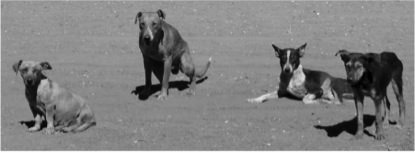
Philosophy deals in big ideas. But what is an idea?
Big ideas today are encrypted in talk of facts and figures, and hidden in screen-size images of objects of desire. We have seen these image-objects on TV or the net, and we carry them around in our heads as unbidden thoughts, as automatic reactions and received postures.
Ideas are taken out of our hands in this process of encryption. We let these images do our thinking for us. ‘Technological advances’, ‘single mothers’, ‘queue jumpers’, ‘budget shortfalls’, ‘celebrity lifestyles’ – all ideas that are captured now as images. We struggle to explain them but feel them to be real.
Consumer culture is urging us to dumb down, to narcotise on the private pleasures of spending and watching, and not to do anything too hard unless we have to - certainly ‘don’t think too much’.
Ideas are received as fragments of the ‘24-hour news cycle’, the ‘sound bite’, the head line and the slogan. They occur as deceptively self-explanatory. Double-speak is everywhere: ‘voluntary redundancy’, ‘everyday low prices’, ‘adult literature’ etc. Things are ‘new and improved’, bureaucrats are ‘serving the people’, things are done ‘in the public interest’ (in the past, were things old and unimproved, politicians self-serving and the public interest not observed?)
We know we are being conned, but because it is the same wherever we look, we accept this suspicion as our private judgement and consume their prescriptions anyway – along with the travel the clothes the family the ‘lifestyle’, all the superficial freedoms of birds in gilded cages …
In consequence, the running of our own lives is surrendered; to ‘red tape’, by-laws, regulations, bureaucracy. We are forced into passivity by every thing from traffic fines and license fees to customer help lines, health care claim forms, finance applications and insurance assessments. We live inside a fine mesh of prohibitions nudging us back into those gilded cages.
It’s as though we inhabit whole aviaries of convention and acceptability, headspaces just large enough for an ordinary life, but in which our freedom of movement is subtly attenuated. Freedom of choice is imperceptibly constrained by market forces, and freedom of speech is surreptitiously governed by anxieties, including the fear of being thought ignorant and the ignominy of not being heard.
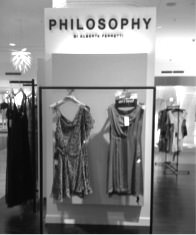
What follows begins a catalogue of big ideas. Shopping, technology, tourism. The screen shot, photo-journalism, the market. And the logic of exchange, the free association of images in the real world.
SHOPPING

The department store is the Real World. In the department store I come up against what matters.
Those items that appear to me as desirable, even indispensable – the lipsticks, the clothes, the household accessories – define a world in which I am ‘truly myself’; hence the urge to buy them and complete myself, express myself, satisfy myself.
I can buy ‘my colours’ at Bon Marché on Paris’s Left Bank (pictured), at Saks Fifth Avenue in New York, at Selfridges in London. Not only can I put on a delicate shade of shell pink or a vibrant scarlet on lips or nails, but in doing so I can become the fashion-conscious urban woman that these practices signify all over the First World.
It is where I am least self-conscious that I am where things matter most. Where else can I ‘lose myself for hours?’ in pleasurable contemplation but when I am shopping? Those things that strike me as desirable, even indispensable – the lipsticks, the clothes, the household accessories – define a world in which I am ‘myself’. Not only what I want, but what I can become, if I just hand over one bit of plastic for another.
Strangely enough, in Selfridges I meet with philosophy. ‘Buy me I’ll change your life’ says the billboard. ‘I shop therefore I am’. I photograph it with my mobile phone.
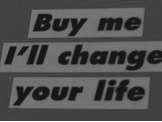
This flippant reference captures the surprising logic of consumerism, gullible and cynical at once. Consumerism, in its aspect as desiring consummations, runs the risk of being gullible. The willing submission of consumers globally desire The Brand™. McDonalds, Prada, Nike … Food, clothing and footwear – all strangely emblematic of people’s social investments as embodied in stuff.
Meanwhile, cynicism haunts the multinational corporation in its pursuit of ‘shareholder value’ above all ethical and sovereign constraints. It seems people desire capitalism, or they crave its satisfactions. They want stuff.
Nothing is perhaps more dispiriting than the overwhelming preoccupation of the web with this consumer pornography. This manufactured phantasmagoria is essentially about investment and projection (and only sometimes about the explicit furtive kind that goes on in the dark…)
IMAGE STREAM

The best is now.
I have two earlier models of these cameras –they are both perfectly functioning digital cameras, purchased within the last five years. But that was then. Where are they now? At best, they are the ‘before’ shot in a ‘before-and-after’ shot.
The point is not so much what this display sells, but what it markets generically. It teaches the consumer how to think.
The dollar sign attached to each individual object serves to link them in a series of equivalent commodities. Buy this – or this – or this. Good – Better – Best. On whatever basis the series is constructed – price, features, currency or brand name – it is grounded in similarity. The series connects terms, not through narrative, historical, causal or logical consequences, but through likeness (and predominantly visual likeness) that can be played on forward or rewind.
What creates value in these objects is their similarity. The sequence protects, supports and promotes their differences into an intelligible whole. The concern is not with causes but with effects, it emphasises surface over depth. Association is propelled by sameness into overwhelming streams of images in consumer culture.
In the overwhelming stream of images, the really different becomes radically invisible.
THE REAL WORLD
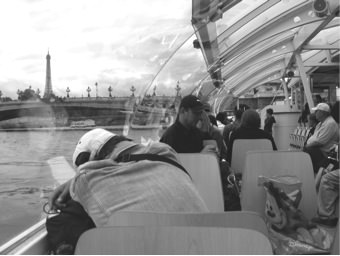
There are more and varied meanings in the plurality of post-colonial worlds than were imagined before. Some of these meanings are misunderstood, and some are contradictory. Some of them are incompatible with others, and sometimes violently conflicting.
Culture is now only observed in the plural, is only ever a comparative event. And yet, at the same time, ‘globalization’ imagines one world, a world of signs and indicators with universal translation. Many of these are economic. They assume a one-size-fits-all rationality that is most clearly articulated in international law and trade relations.
But how do people from widely differing cultural perspectives come together in any sense of the ‘global’? It is not through this rationality and its arguments that these encounters take place. However distinct from each other – Tokyo and Sydney, New York and London, the Tanami or the Sudan – the global is colonized by images.
From the high art canvas to the mass media televised news bulletin – images circulate throughout the ‘Real World’, soliciting viewers to respond as they can. And these responses are constituted from the feelings called up in viewers through the action of the image. From sympathy to envy, from anger to shame, affects are mobilized that can ‘make love or war’, that build community or ignite paranoia.
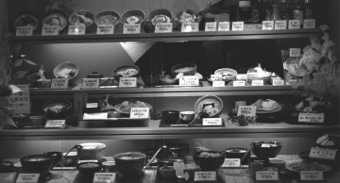
PHOTOJOURNALISM
When I’m watching the news on television, I am wholly immersed in the scene, believing it to be real.
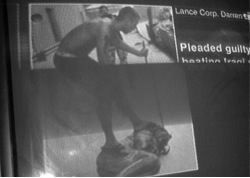
The press photograph proposes an unmediated reality. But of course, however realistic it appears, the photograph remains an image. Appearances deceive. We infer from our own general knowledge that the newspaper photograph has been chosen, composed, constructed and treated according to professional, aesthetic, or ideological norms. And it is read, connected more or less consciously by the public that consumes it, to a traditional stock of signs.
The objectivity of the photograph is mythical, in the sense that it harbours a belief that gives meaning to other cultural signs. Of course, photojournalism would be regarded in common sense as the antithesis of the sacred, but this only shows how deeply held the myth of the photograph as a record of the real is.
The inherent religiosity invested in the famous image of the twin towers burning on September 11 makes the point. With its iconography of crucifixion, and the surrounding rhetoric of the axis of evil and the sanctity of American life, a reality sprung out of the image of apocalyptic change, and: ‘the world will never be the same’.
In more ways than many, this media event raises knowingness of the production of the real through images; for example, many have remarked on how this photo (and the video of the same events) are like a disaster movie, its spectacular capture creating an iconic photo-opportunity. The myth of the separation of reality and image is paradoxically so strong that most viewers have no trouble identifying the press photograph as a depiction of what happened.
The representations of photojournalism are generically ubiquitous and forceful. This genre is often marked by trauma and violence as the mode by which it sticks different figures together. Photojournalists use their images to arrest the attention of a knowing viewer bombarded with a constant stream of images all soliciting affects of some sort.
Such is life in the media. But the distinction between the representation and its historical event can slip from a reliable grasp, as atrocity and the tendentiousness of its image become more firmly glued together. War correspondents have traded on the trauma of the battle in order to achieve their effect of bringing events from elsewhere to the attention of the public. Sometimes this enterprise is undertaken to bring to recognition the injustice being done in a part of the world we don’t witness.
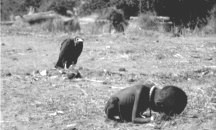
Kevin Carter’s infamous photograph of the child and the vulture from Sudan is a case in point. It contains an importantly ambivalent relation to horror and trauma, since it depicts nothing in the present, except the menace of the near future. It is what we bring from our own knowledge of the world, what will happen next, that sickens us in this terrifying image. It won Carter the 1994 Pulitzer Prize.
This photograph operates to cultivate the loss of something previously unmissed; the Sudanese other, in the aftermath of European colonialism in Africa. Like the holocaust of World War II, this is an event that exceeds representation for the European subjects, who nevertheless must come to mourn it if there is to be justice.
Among the accolades came criticism for the culture of the photojournalist, to whom representation became more of an imperative than reality: “The man adjusting his lens to take just the right frame of her suffering might just as well be a predator, another vulture on the scene”, as the St Petersburg (Florida) Times put it.
The strength of the image’s success in creating an affect for a representation of an event might be measured in the prestige of the Pulitzer. It can also be measured in Carter’s own anguished suicide following the award of the prize.
DARK TOURISM

The artlessness of cultural tourism comes to something of a halt at Dachau. Literally, at the railway station called that, which is just one stop on a suburban Munich line. These days it’s known as “dark tourism”, the organized inspection of the sites of atrocities and tragedies, as well as of treasures and marvels.
In the wake of the Jewish Holocaust, philosopher Hannah Arendt wrote of the banality of evil. The concentration camp at Dachau is a terrible spectacle, not least because of the impermanent look of its buildings, the temporary and undistinguished huts in which hideous suffering was made commonplace. These places can hardly bear the weight of the scrutiny they must now receive from history. The most solid thing about Dachau seems to have been the motto, cast in iron, over the gate: ‘Work makes us free’.
Bruno Bettelheim, in his book The Informed Heart, remembers the German Jewish bourgeoises who could not leave behind their possessions and therefore remained to die in Nazi Germany:
My young relative was unable to convince some members of his family to go with him when he left … his family clung more desperately to the old living arrangements, the possessions they had accumulated over a lifetime.
It was like a parallel process in which their life energies were drained away while their possessions seemed to give them a pseudo-security to replace the real assurance that no longer came from planning for their lives. Again like children, they preferred to cling desperately to some objects in which they had invested all the meaning they could no longer find in their lives. As they withdrew from the fight for survival, their lives began to reside more and more in these dead objects and the persons in them died piece by piece, little object by little object.
Bettelheim contrasts this response with the groups of others who, when they saw the writing on the wall, organised themselves into strategic positions in the SS, into political cells, into obtaining papers for emigration etc.
In exploring the psychology of the totalitarian society, and the mass society which shares features with it, Bettelheim draws the conclusion that psychoanalysis is fine as far as it goes, but that changing the environment is a much more effective way of changing personality. He finds the limit of the talking cure in his own experience of a radically changed environment, as an inmate of Buchenwald.
Looking for an explanation of how the German people could have accepted the totalitarian tyranny of the Third Reich, he reflects on those victims of the Nazi state who perished under the weight of their earthly possessions. “Refugees fleeing the invading German armies were everywhere bogged down by the load of goods they carted in wagons, barrows, bicycles or on their backs, because they could not bring themselves to face life without them.”
Bettelheim argues that, as citizens or as concentration camp inmates, Germans, Jews and the other targetted groups were all persecuted by the Nazis, for the aim of the totalitarian state was to deprive every individual of his autonomy, to infantilize people by overriding their will, and thus to guarantee obedience. The structural difference between the camps and the larger society, in terms of this process of disintegration in the personality, was time: the concentration camp was faster-acting, because its terror and deprivation were more complete, as dramatised in explicit and relentless violence.
But the role of the concentration camp in the wider society was to posit a continuum with it: 'The particular anxiety generated by the threat of the concentration camp was, after fear for one's life, anxiety about what might be called one's moral existence. It poses the question: If resisting the state deprives me of my social status in society and within the family, of my home and earthly possessions, will I be able to make a go of life without what has always been my main source of security? Only those who knew for sure what was ephemeral and what essential, in themselves and in their life, and that the essential would stay with them no matter what, could easily take action toward ending their anxiety. They tried either to fight or to escape.'
For others, this created a psychical vicious circle. : Whether or not Germans realised it consciously, the longer they lived under threat, the more energy it took to manage anxiety, the less inner energy remained for the courage to act, and the more they were thrown back on externals that had formerly kept them going in times of stress. It was the same process that led to distintegration in many apolitical middle-class prisoners, though in the camps it happened faster.'
It is clear that this trap of possession, this bondage to possessions as Bettelheim calls it, is not mere greed - although greed is itself much more than a moral failing (as a psychoanalysis of envy reveals).
But it is tempting to say these people were possessed by their possessions far more than they possessed them. And perhaps the notion of property as such is more ambivalent than the confident assertion of ownership and control.
The properties of things - the colour of the curtains, no less than the strength of one's character - are bonded in integral ways. These are nevertheless imaginary bonds - all the more compelling for arresting us in the order of the imaginary, which is the order of our identity. We speak of having possessions, but they can only be had psychically by their ‘introjection’ as an image. In the process of taking these things in, we become as indentured to them as they to us.
Lacan asks us to see our bonds as imaginary in that other sense of literally unfounded, or more precisely as a méconnaissance, a misrecognition. Love is in general 'in the dimension of making a mistake', he writes, by identifying objects with and as oneself without awareness of the open-ended character of desire, which can always disinvest.
Bettelheim describes a relation to objects that is not lethal - but such a relation is not possession. He argues that technology has made possible the recognition that objects are far less vital to us than they used to be, ‘since it no longer takes a year's labour to acquire one good suit, or a good bed and mattress.’ But the environment must support this investment, or we would regress, as did the citizens of the Third Reich, to more 'infantile' modes of possession.
The contradiction in modern consumer mass society is that the means to move beyond objects is more available than ever, and yet the social world is more than ever invested in the overwhelming relation to objects, as commodities as stuff. The real world does not support the psychical investment in modes other than possession of objects.
Our belonging to this world still leaves us vulnerable so that, were that bond to be ruptured, it would simply leave us as individuals – as it did the bourgeois Jewish German citizens - outside imaginable, and therefore livable, life.
Technological change may be testing the tensile strength of these imaginary bonds, but not yet in the direction of our psychical autonomy.
screen shots

The screen shot epitomises the free associative thinking that seems to follow peculiarly from the internet. Free association isn’t random, it is just unrestrained by ordinary logical processes.
The screen shot can frame specifics while capturing their social and commercial context in the menu bars and the pointers. It can register the currency and poignancy of the subject in its images. And the screen shot is free. Operating systems on most viewing devices include an inbuilt function for taking screen shots. The screen shot above all is an image, and creates an image of a thought, the freeze frame in the flow of real world logic.
The screen shot is emblematic of the cluster of problems presented to thinking by the internet, which are now on a scale to rival the organisations of nation states. The internet, as the materialisation of free association and the systemic deployment of an image logic, is key to the ‘teletechnological’ model of creating value. The ubiquitous metaphor of the viral in relation to the internet’s action doesn’t quite capture it.
It is through the action of the image that the associations are transmissible, and that investments compound and proliferate. Things rendered as images become thinkable as objects of exchange. And commodity fetishism describes the more-than-material that propels value creation. The making social of things and the making thingly of the social bond is critical to understanding value creation in the era of the internet.
The internet, as an image of freedom – a free community of information freely given - is now corrupted, if it wasn’t always hopelessly naive, by its capture in the nets of commerce.
free market
Wikipedia defines a business model as ‘the rationale of how an organisation creates, delivers and captures value (economic, social, cultural …)’.
Familiar business models include the flatpack DIY home furnishing (Ikea), bricks-and-clicks (David Jones online), bait-and-hook (printer and cartridges), franchise (Muffin Break), and online auction (eBay).
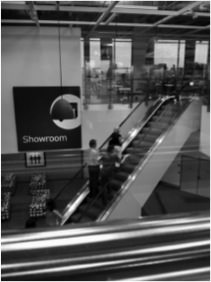
How to get free stuff to pay? ‘To monetise’ is the new verb for it. The business model for carsales.com.au monetises in exemplary fashion. It no longer needs to provide anything other than the classified ad display. The typical ad now appearing on carsales.com would have previously appeared in the newspaper with its high costs of printing and distribution, not to mention the exorbitant cost of maintaining an editorial environment of news reporting and quality journalism around it.
The underlying shales of the stock market expose us to ‘market sentiment’. That sentiment can be unvarnished. Because of the international nature of electronic investment, the local market is subject to global ‘market risk’, that may have little to do with the viability of listed companies on individual exchanges as measured by, for eg, price to earnings ratios.
The internet as cause and effect of globalisation is now entrenched in the market: Its speed, automation and reach contributed significantly to the panic of the Global Financial Crisis. The idea of the business model as rationale calls up the skewed logic of instrumental thinking – it goes by the name of rationalising. The rationale, in this use of the word, is a concept that takes over the whole of thinking, even the name of thinking, for instrumental means and ends.
Despite the language of ‘rationalisation’, ‘economic rationalism’ etc, the market can’t be relied on to be rational; business journalist Alan Kohler described a volatile afternoon through the unfolding of the GFC as traders acting ‘like kids on red cordial’.
The frightening paradox of the market is that, for all it is presented as a blind force of indefeasible calculation – even of rationalism – it is dominated by the notion of its moods. ‘Investor sentiment’, ‘business confidence’, the twin antimonies of fear and greed: while economics is a science for pessimists, the market is a place of pragmatists betting on other people’s feelings. Or so it seems.
This is the mad empiricism of the global markets, where ‘market sentiment’ collects together the fugitive and irrational moments of investor behaviour, and spins it into objective fact.
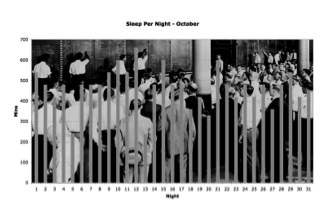
Traders use technical analysis to decide whether to buy, sell or hold. In the candlestick chart, the movement of the price, not merely its position, can be seen on inspection, highlighting trends. The candlestick method of charting was developed in the eighteenth century by Japanese rice traders, but is now widely used to depict securities, derivatives and currency movements, all elements largely determined by sentiment.
The trend is of course a trajectory across time. It can create the illusion of seeing the future. It may promise to alleviate risk. Yet the direction is a mirage, never quite capturing the moment at which the traders run to the other side of the ship.
Artist Helen Grace asks us to speculate on ‘What happens when the private individual goes public, floating himself or herself into the stream of risky capital flows?’ Is this fantasy - or is it Facebook? Social media, the sites where people perform themselves ‘for fun and profit’, make the question urgent. ‘How do we survive in a market-dominated world, which devalues and discounts life and labour? What prospects currently exist for maximising returns on a public offering of the individual body and its emotional states?’ That remains to be seen.
Grace’s graphs make changing moods and emotional states into empirical realities via the logic of the ‘candlestick’ chart, a stock in trade of ‘technical analysis’. In her ‘Sleep Per Night – April-December 2008’, minutes of sleep are plotted against days of the month, overlaid on a sepia photograph of the trading floor of the Chicago Board of Trade. The ‘bio-data’ is generated from the artist’s own diaries from the time, which was a time of sleepless nights for investors.
The bar graph becomes a simple and forceful presentation of the difficulty of living the GFC, where everyone has something on the (bottom) line. Thus, a series of ‘bio-data sets’ chart not only sleep per night, but ‘general anxiety’, ‘state of happiness’, ‘sense of security and belonging’ and ‘filial sentiment’ for the period, generating a self-portrait with cerebral intent.
In presenting her own emotional life as a kind of data the market could use, Grace performs a significant condensation: the impossible vagaries of individual mood are transposed onto the attempt of the market to leverage collectivised mood in its movement. It is of course a feedback loop; the more consumer sentiment lags, the more economic performance drags.
If the market historically has a gender, it is feminine – its hysteria and fickleness apparently tell us that. And if the market had a body, it would thereby be premenstrual, or worse, peri-menopausal; labile, unreasonable, over-heated, upset. Grace’s series of graphs, compiled from diary entries, evoke the abjection of unruly aspects of life beyond economics, the moods and sentiments of the lived body.
Grace reflects on another action of the market, the speculation on the future of necessary commodities. The graphs are suspended over photographs of Asian workers in the paddy fields, introducing the Marxian insight that production is built on (someone else’s) labour.
These charts call to mind the Asiatic mode of production and the tsunami of late industrial capitalism wreaking havoc on third world staples. Speculation on the future of this crop is also betting for or against starvation, a real anxiety given drought and loss of land for edible crop planting to bio-fuels harvest. Grace punctuates this musing on Marx with the ‘Index of Creative Thought April – December 2008’, visualising the value of the artist’s work as a commodity.
‘Everywhere you turn and on every surface and screen, there are images of beautiful figures, lines ever rising skyward and cloudless blue skies promising infinite growth, security and high return. It seems that economics itself is a sublime landscape, while at the same time, art is merely another asset class.’ (Helen Grace, ‘IPO’ catalogue)
In her ‘day job’ as a cultural studies academic, Grace says that the task of the humanities is pattern recognition. Her ‘graphs’ show pattern recognition to be an aesthetic form. She gestures toward the creative power of facts and figures, which through being visualised, are producing value as much as recording it.
She notes the greater visualisation of the markets coincides with the disappearance of visual drama from stock market trading floors. In the same way, we ourselves are ‘dematerialised’ from physical forms to data flows, in the speculation on our wants and needs. This speculation is a form of abstraction that has become lethal in the global tumult.
technological thinking
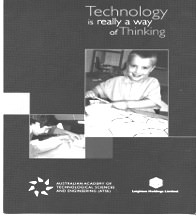
The more disturbing pressures of instrumentalism come not from the commodity, but from the culture of accountability being instituted in its name, with its attendant bureaucracy.
Accountability is not to the consumer, except indirectly; arguably it is to instrumentalism itself as the proper measure of ‘quality’. We are exasperated by the administrivia that encroaches in everyday life, regarding it as an annoying impost. But this view is too sanguine as to the power of the bureaucratic, to institute its own forms of life.
Bureaucracy begins as the attempt to think every detail of a practice rationally, to submit it to the means and ends of a ‘rational’ thought that is indifferent to particular thinkers and actors at particular times. It is an effort to schematise the difference of individual particulars of the case.
It can be contrasted for example with casuistry, which builds its knowledge from repeated experience of practice. In bureaucracy, the movement is in the other direction, from the principle to the particulars classified under it in actual events in time.
The bureaucratic description of a future possibility is an act of the highest invention. This is why the production of ‘policy’ is a struggle, to articulate unruly life as the operation in practice of an underlying principle.
Conflict arises where this conduct has other naming, other experiences. Take the inflammatory area of ‘sexual discrimination’. The wolf whistle, that has previously appeared to some in an everyday casuistry to be the expression of sexual desire for an object in a public domain not primarily given to the satisfaction of the sexual, now becomes ‘harassment’ because it does just that, reduces a situation to one of sexual objectification.
Sexual objectification is seen now in this principle to be in conflict with the presence together of these sexual subjects and objects as persons with working roles and responsibilities. It clearly is an intrusion into the discourse of subjects working together to invoke this other ethos, of sexual predation (or even mere admiration). This is why some subjects (men, usually) find the new principle so incomprehensible – it obstructs their affects that elsewhere they pursue unthinkingly of subject relating to sexual object. Their affect is suddenly illegitimate, despite their experiencing it.
This is not to defend the man who thinks there’s ‘no harm in admiring a pretty girl’. I am pointing to how the effort to cloak future undisclosed events in a prior reading of their meaning will only always struggle to succeed, and will in certain senses inevitably fail – ‘life’ will exceed it. But once the law underwrites this schematising, the errant sexual affect is called illegal, and subjects must learn to redefine their experience accordingly.
The redefinition of experiences by the bureaucratic is a continuing invention; the growing edge of policy is into the various areas of experience hitherto experienced under different discourses, and given different names. This is why even the ’beneficiaries’ of this renaming – for example, women – may experience its intervention as somehow artificial and not always what they want.
The bureaucratic seeks to schematise life under principle. This argument could lead us to more disturbing observation of the latent violence to be found in imposing law on life in general. From the everyday harassment of new regulation of practices as diverse as sexuality, family life and scholarship to the monstrous imposition of principle that a mass genocide as an act of policy in Nazi death camps brought to pass, bureaucracy’s rational limit is only finally satisfied in destruction of the unruly particular in the name of principle.
Bureaucracy then, as the acting out of the technological, continually enacts its danger; the colonising of experience by a rationality that understands only its own mode, the production of means for similarly-produced ends. An intelligence that nevertheless recognises only its own genius and for which other intelligences remain uncomprehended.
why feral philosophy now?
Philosophy was born of democracy. ‘Everyone is entitled to their opinion.’ The rise of democracy, the promotion of mass literacy, the development of free choice ought to mean we can all now can discern exactly what is going on around us.
And yet, has there ever been a period of such deception in the authorised view of things versus the actual experience of life? The 21st century seems to be shaping up to be the century of greatest illusions, where we are urged to live and aspire to things – like freedom, prosperity, peace and self-expression - that are nothing like the realities we encounter pursuing them.
It is as an era in which we are trained in self-deception. From instant gratification to equal opportunity to happy marriages, fulfilling careers, beautiful bodies, amazing sex and health and wellbeing throughout our increased life spans … we are trained to deny the realities, to overlook the inequities and to understand our own discontent, where it breaks through, as pain for which we medicate rather than adjust real circumstances.
The increasing redundancy of thinking for oneself, the continuing temptation to outsource our dealing with big ideas is not in our interest. The strong methods and vigorous techniques of a kind of philosophy are needed more than ever today. The unexamined life is not worth living, said Plato. Philosophy is the oldest search for truth, and its name means love of wisdom. But just when it is most needed, philosophy as it is taught now has passed up its responsibility to truth-telling.
The ordinary person would be hard-pressed to specify how philosophy has anything to do with their lives. Despite its reputation as a repository of human wisdom, philosophy is now just a soothing word for nothing vital, an antique practice for gentlemen along the same lines as polo.
Philosophy has thrown in the towel on the subject of wisdom – it embarrasses professional philosophers to even use this word. Instead they create an esoteric vocabulary through which they joust with each other in academic cloisters far from the madding crowd.
There is in feral philosophy a strong streak of rebelling against the proper, the official and the academic. It reclaims the place of thinking as everyone’s birthright, thinking as what comes naturally, as something that shouldn’t be taken from ordinary people and locked up in a glass case in an ivory tower where only a certain kind of grandee can have access to it.
The history of philosophy is full of protest, of people asserting their independent thought in the face of tyranny and ostracism. They have done so because of the realisation that life isn’t worth living without it.
It’s in philosophy’s nature to be oppositional; it’s in its history. The consolation of philosophy was written by Boethius from his prison cell. Foucault was thinking through the history of sexuality in the gay bathhouses of San Francisco. Socrates declares his love for the law as he swallows the hemlock he has been condemned to drink as his death sentence. Agamben writes of what would be ‘bare life’, in the shadow of the concentration camps of Nazi Germany.
Philosophy goes feral in response to the disenfranchising of ideas. Philosophy going feral involves going beyond the ordinary forms of truth offered us today – the scientific facts, the economic figures, the sales data, the polls, the medical research, the political spin and the self-help gurus – to understand the stranger contradictions of twenty first century first world life.
In feral philosophy, aesthetics, for example -the creation of beauty, desire and judgment (its traditional subjects) – would be taken into shopping malls, museum cafes and media outlets where today we find value produced as a commodity for purchase.
Ethics, the place of ideas about living the good life, would be taken up in our relations to romantic love, the family and among democratic citizens. Our ideas about how to live are dictated by what’s possible in the Real World; what’s ‘normal’ according to sociological research, and what we’re worth, as outlined in self-help books. The global village is a large place, but it’s where we now get to speak about our duties to others.
Metaphysics, traditionally the space for discernment of reality, would be found in evaluating the science that makes us who we are – from biology to medicine, psychiatry to anthropology to technology. The area is dominated by discussions of the relation of body and mind, especially as science now reduces the mind to the brain as a special case of the body, while abstracting what were uniquely human capacities into the virtual space of artificial intelligence.
And logic, perhaps the least understood of all the philosophical branches, would become the place to analyse the thought-systems that make our world make sense. Things become intelligible today through information, the market and bureaucracy. These central principles organise everyday life, as the world wide web catches us all up in its nets.
The practice of a feral philosophy would look at the big ideas as they happen to us in the real world, which is itself one of the most potent of the big ideas we live with. It would explore why it is that things are not as they seem, and how to bring the difference between truth and illusion into focus.
Biography
Assoc. Prof. Robyn Ferrell is a research associate in the Department of Gender and Cultural Studies at the University of Sydney. She is the author of Sacred Exchanges: Images in Global Contexts (Columbia UP 2012) along with several other books of philosophy. Her book of creative nonfiction The Real Desire was shortlisted for the 2005 NSW Premiers’ Award.

